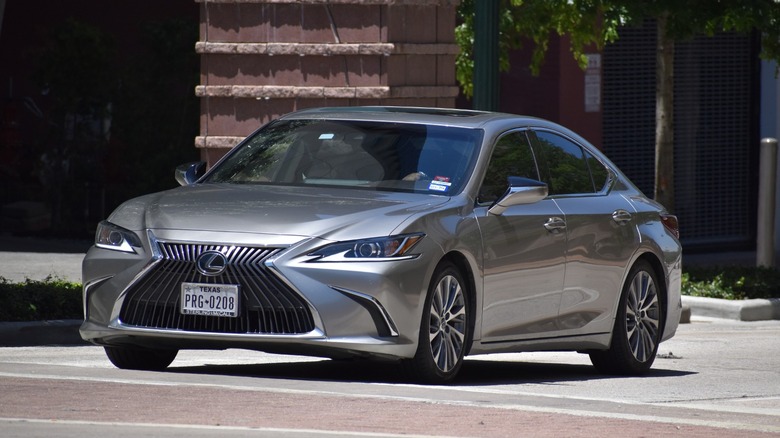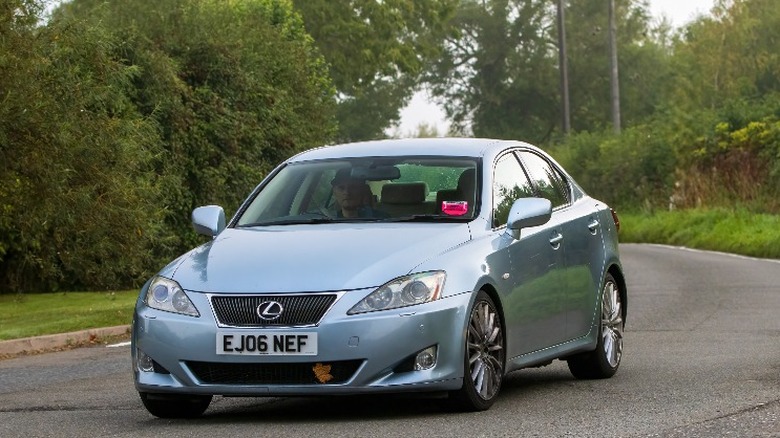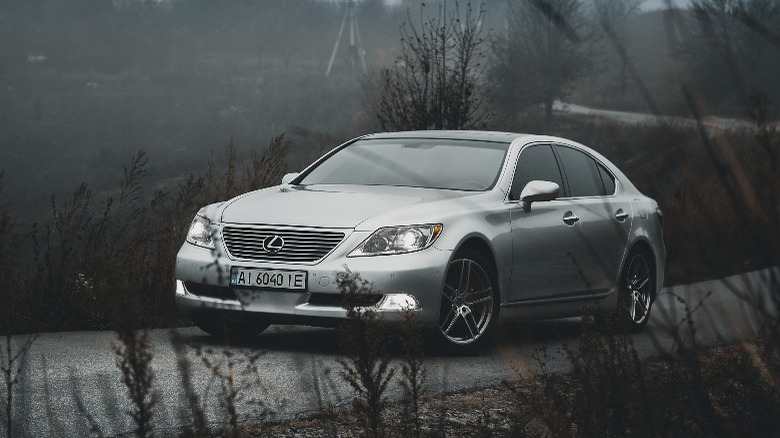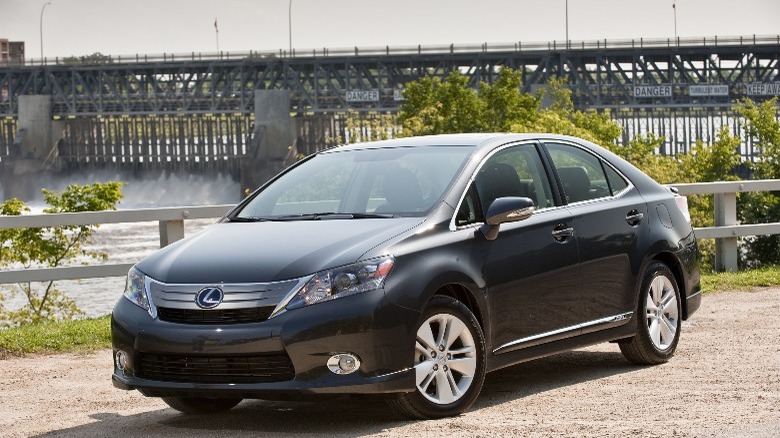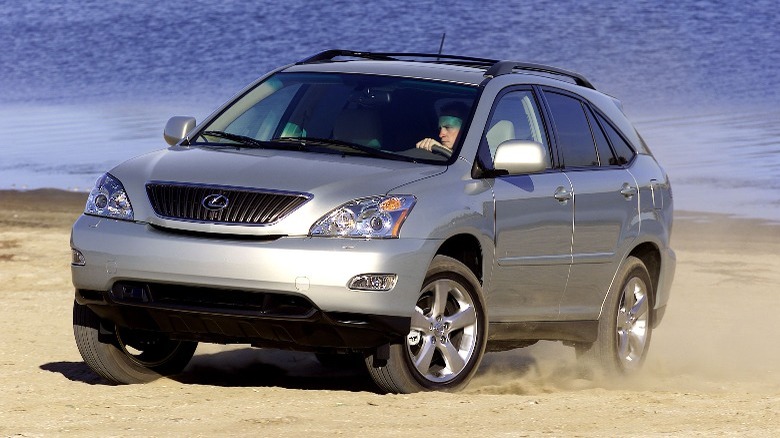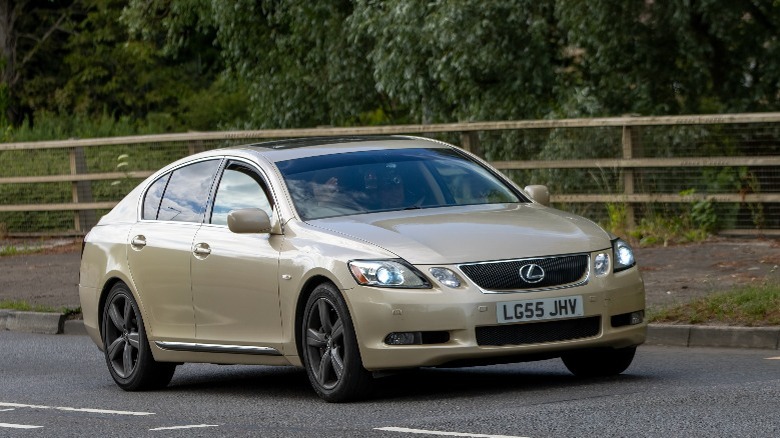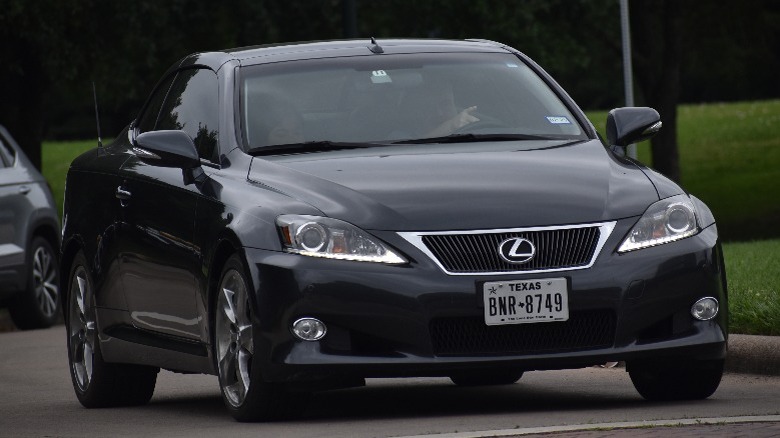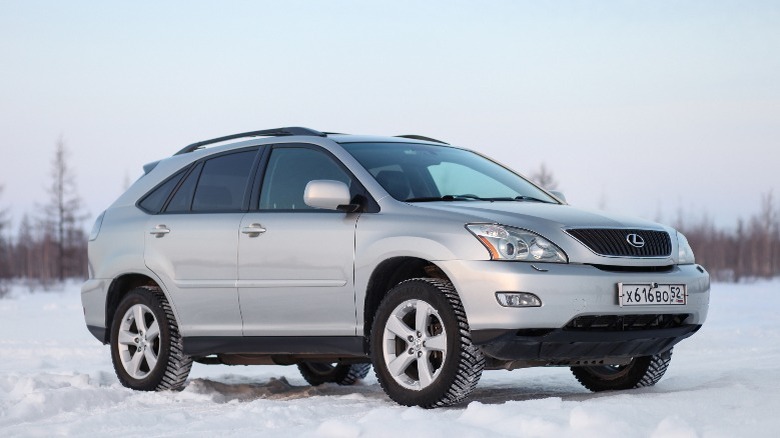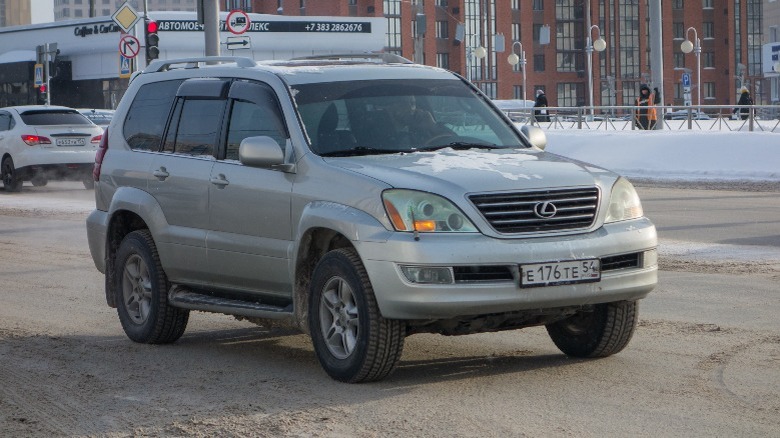8 Used Lexus Models You Should Steer Clear Of At All Costs
Lexus is actually a division of Toyota, one of the biggest car manufacturers in the world. But unlike its parent company, Lexus targets the luxury end of the automobile market, and it's built a reputation for reliability, comfort, and state-of-the-art technology. But not all its models are created equal, and like with any other brand, buying a used model can be a gamble compared to purchasing new. A used vehicle will have accumulated mileage and wear and tear, which means more potential problems and higher maintenance costs. Even if you get it dirt-cheap, a used car can quickly become more expensive.
Toyota has had a number of recall scandals over the years. For example, in 2013, over a million Toyota vehicles were recalled, including some Lexus models, because there was a chance the airbags would deploy unexpectedly, possibly hurting any passengers in the car. Some other recalls were made due to faulty brake systems, and other mechanical issues like transmission failures or engine problems.
Several Lexus models have gained a reputation for becoming more problematic over time. Of course, everyone's experiences will be different, and you might be lucky enough to score one of these models in great condition, but it's always better to be well-informed before you decide to take the plunge. Let's have a look at some of these models and run down why they may not be the best choice when buying used.
Lexus IS250 (2007-2012)
First up on the list is the second-generation IS250, which has earned a reputation as the Lexus model to absolutely avoid. The release of the IS250 saw a transition from a multi-point fuel injection system in the engine to a direct injection system instead. This should have made for a more fuel-efficient model, but a lot of owners started to notice carbon buildup in the intake valves and injectors down the line. This can cause a plethora of issues, including your engine misfiring and even fluctuating or shuddering at idle speeds, also known as rough idle. But that's just the tip of the iceberg.
Even more concerning with the IS250 is the number of recalls that have been issued by the NHTSA, especially with the 2007 model. One recall was made based on there being a potential for the floor mat to interfere with the accelerator pedal causing the throttle of the engine to enter the wide open position. In simpler terms, this pretty much means that there's a chance that the floor mat causes the accelerator pedal to be pushed all the way down and make your car move at full speed. The NHTSA estimated that there are almost 4.5 million cars affected by this, which is an extremely significant number. There are also more minor issues to be aware of, like discoloration of the inside rearview mirror and melting of the dashboard.
Lexus LS460 (2007-2012)
The LS in LS460 stands for "Luxury Sedan", and the LS line is thought by some to be one of Lexus' most iconic models ever. It's loved for its comfort, reliability, top-of-the-line technology, and as the name implies, luxurious look and interior. However, though it might seem like the epitome of luxury, there are a few potential problems with the early models of the LS460 that you should factor in when deciding to purchase one used. One complaint that a number of 2007-2012 LS460 owners have made to the NHTSA is the potential for the brake actuator to malfunction or sometimes totally fail which puts you at risk when driving, especially when you need to brake in an emergency.
When this was brought to its attention in 2016, Lexus started an extended warranty program to replace the brake actuator assembly. But based on the warranty requirements for buyers claiming after 2017, it's extremely unlikely that if you're buying a used LS460 with this issue today your car will be covered, and replacing the module will cost you a pretty penny. Also, the NHTSA issued a recall on over 100,000 cars produced by Toyota and Lexus due an issue with the valve springs that could cause the engine to suddenly fail, even when the car is in motion. Of course, there's a chance that you get an unaffected model, but this wasn't the only recall made to these models, so it's better to skip them altogether.
Lexus HS250h
The HS250h was Lexus' attempt to create its own version of the widely successful Toyota Prius and merge luxury with fuel efficiency. It marked the brand's first toe-dip into manufacturing dedicated hybrid cars, but it wasn't quite the success it envisioned, with a set of issues that led to it being axed after just 3 years. Since its release, the NHTSA has issued 7 recalls on the HS250h for several safety risks including potential complete loss of motive power, defects in the suspension that could cause you to lose control of the car when driving, and brake malfunctions. But Lexus learned from its mistakes and has since released a number of hybrid models that are worth considering over the HS250h, like the CT200h.
Recalls aside, people were generally disappointed with the HS250 when it launched. It had a surprisingly noisy engine that made a loud, droning sound during acceleration, lacking the signature Lexus quietness, and its ride was far less smooth than the Prius it tried to imitate. There was also the issue of people feeling like the size of the exterior was misleading when you took into account the relatively small interior.
Lexus RX330 (2004-2006)
Another model to watch out for is the Lexus RX330, the second generation of the RX series, which was produced from 2004 to 2006. While the newer models of the RX series are far more reliable, these earlier models were plagued with a number of issues that only got worse with age. The RX330 is notorious for the brakes failing on the drivers of these cars, with some owners even reporting that they ended up in serious crashes because the car just wouldn't stop, even when they were pushing down on the brake pedal all the way.
In 2010, Toyota notified the NHTSA of an issue where some brake fluid could slowly leak into the brake boosters, which would cause a "spongy" sensation when the brake pedal is pushed down, and eventually the brake function of the car would deteriorate. All of this is to say that after extended use, you could be dealing with the issue of a defective braking system, with Lexus themselves saying that this could cause a crash. A recall was issued and the NHTSA estimated that over 700,000 Toyota-produced cars were affected, which is a lot considering that the RX330 wasn't in production for very long. Some other problems with the RX330 that owners have reported include stiff steering, oil leaks, and issues with the transmission like rough shifting and premature failure.
Lexus GS300 (2006-2008)
When the GS series was released, it was intended to fall in the middle of Lexus' sports sedan spectrum, between the smaller compact IS series and the bigger flagship LS series, and people loved it. Since its release the cars have become known for comfortable, luxurious interiors, and distinct styling that's sportier than other luxury sedans. The GS300 has seen many iterations, and though they've mostly been well received, there have been a couple of low points, particularly with the third-generation models which were in production from 2006 to 2011.
Recalls have been issued on the 2006 and 2007 models of the GS300, mainly for issues regarding the fuel delivery system. One recall was made based on a problem where the fuel pressure sensor wasn't tightened enough on a significant number of units, leading to a fuel leak. Another recall was made because there was a possibility that fuel could corrode the delivery pipes and create a hole in it, which would also cause a leak. The NHTSA saw this as a safety hazard because it could potentially start a fire if there was an ignition source nearby. Another thing to note is that the engine in GS300 uses a direct fuel injection system, which as we said earlier opens you up to having to deal with carbon buildup in the intake valves.
Lexus ES350 (2007-2008)
The ES350 made its debut as the fifth generation of the ES series for the 2007 model year. It wasn't meant to be a performance-focused machine, but instead, it comfortably got you where you needed to go in a luxurious, quiet cabin.
However, like a lot of other Lexus models from this era, the ES350, particularly the 2007 and 2008 models, had a very serious problem with dashboard and interior door panels melting over time due to heat exposure or humidity. This would lead to the entire dashboard initially having a shiny look when it started to melt, eventually becoming sticky or starting to crack. Lexus started a warranty program to replace the dashboard and door panels for 10 years from when the car was first used. But since you'll be buying used, if the first owner never had it replaced, it's unfortunately likely you'll have to pay out of pocket to get it done.
The ES350 also had several serious recalls issued, three of them affecting over 3 million units in total. This had to do with the possibility of sharp metal fragments hitting passengers in the car if the airbag was deployed in an accident. There was also another pretty serious recall concerning the same accelerator entrapment issue that the IS250 was recalled for, and almost 4.5 million cars were affected by this
Lexus RX350 (2007-2009)
The RX series, standing for "Radiant Crossover," is Lexus' line of midsize crossover SUVs. First introduced in Japan for the 1998 model year, the release of the RX marked the world's first luxury crossover, offering the premium driving experience typical of luxury brands like Lexus alongside the practicality and versatility of an SUV. The RX350 was one of the second-generation models of the RX series, and while later models receive almost no complaints, the earlier models have a couple of issues that you might want to know about before deciding to get one.
Problems with the RX350 are extremely similar to that of RX330. One commonly experienced mishap is shift lag, when there is a noticeable delay between when your car shifts gears and when the transmission responds. Dashboard cracking, melting, and stickiness is another common issue, just like a lot of other Lexus models produced during this period. There are also other minor issues like oil leaks and intermittent oil pressure, as well as problems with the air conditioning. It's also worth mentioning that over 700,000 cars which include some RX350's were recalled because of an issue where the retention clips for the floor carpet could interfere with the accelerator pedal and cause the car to speed up unintentionally, which could lead to a crash.
Lexus GX470 (2005-2009)
Debuting in 2002 and remaining a staple in Lexus' lineup, the GX series has always been a strong contender in the midsize SUV market. If you're considering a used model, the first-generation GX 470 is actually a solid option compared to others on this list (though the GX 460 is a more reliable Lexus car, in general). It has had far fewer recalls issued by the NHTSA, and there aren't many complaints from long-time users. But it's not completely perfect, and there are some possible issues you could experience, especially when opting for an older model.
One of the more troublesome (though infrequent) issues with the GX470 involves the secondary air injection system. In some cases, the air pump can transfer debris into the valves of the injection system, causing them to malfunction and triggering the check engine light. When this happens, you might experience a loud booming noise when you start up your car. If this happens, the entire air injection system will need replacing because of the way it's designed — trying to find and remove the debris won't cut it. You should also watch out for problematic side curtain shield airbags, as a recall was issued in 2016 regarding this problem
